After 6 years of hut-to-hut hiking in the Pyrenees, we’ve learned a thing or two about what to pack (and what to leave behind!). The Pyrenees are full of unforgettable moments, but only if you’re prepared for whatever the mountains throw your way (freezing mornings to surprise storms and noisy neighbours!).
That’s why we’ve put together this list of 10 things we never forget when hitting the trails. Some things are typical, though maybe you wouldn’t think they’re necessary in the Pyrenees, while others might come to you as a surprise.
But we can assure you these essentials make every adventure more comfortable, safe, and enjoyable, whether it’s your first hut-to-hut hiking trip in the Pyrenees or your tenth!

Earplugs
This is one of the most essential items to pack for hut-to-hut hiking in the Pyrenees!
Why? Unlike huts in the Alps or Dolomites, huts in the Pyrenees don’t have private rooms. Instead, you’ll share a room with others (the smallest we’ve stayed in had six beds). So, there’s a good chance someone will snore.
After a long day of hiking, it can be incredibly frustrating to lie awake because of the noise, especially when you need a good night’s sleep to tackle the next day’s trails.
So, our solution is to pack earplugs. They’re not perfect, and you might still hear the neighbour snoring, but they’ll significantly reduce the noise and help you get some rest.
Another option is to bring headphones. If you do so, make sure to download music or an audiobook before your trip, as most huts don’t have WiFi or mobile data.

Emergency blanket
This item only costs 5€ and can save your life in the mountains. Plus, it’s so compact and lightweight that you won’t even notice it in your backpack.
We’ve never had to use one (and we hope it stays that way!), but we keep at least one emergency blanket in every backpack we own.
But why are they useful?
♨️ Emergency blankets reflect about 90% of your body heat back to you, helping prevent hypothermia. Imagine you sprain your ankle and need to wait for the rescue team to come. You’re standing still, so your body quickly loses heat, and you get cold. Wrapping yourself in an emergency blanket can keep you warm while you wait.
🧊 But emergency blankets aren’t just for the cold. They can also keep you cool when it’s super hot outside. If you need to make a stop at a peak or a mountain pass (where shade is usually non-existent), you can use the blanket as a sunshade to protect yourself from the heat.
🌬️ They are also really useful to protect against the wind and rain. These blankets are made from waterproof and windproof materials, so they act as a barrier against cold winds or rain if bad weather hits and you have no shelter.
🆘 Another reason to pack an emergency blanket is because of its colour. Their metallic or bright colours make them highly visible, which can be a lifesaver if you need to signal for help or make yourself noticeable to rescue teams.
Okay, that’s great. But how do you actually use an emergency blanket?
Emergency blankets have two sides: a silver and a gold (or sometimes orange) one.
To stay warm, wrap yourself with the gold side facing outwards. The silver side reflects your body heat back to you. To stay cool, wrap yourself with the silver side facing outwards. This reflects the sun’s rays, keeping you cooler.
Cash
Although some huts accept card payments, the majority don’t. You’ll need cash to pay for your reservation, the shower, and the extra food or drinks you might want.
And trust us, after a long day of hiking, you’ll definitely want to enjoy a cold drink!

Waterproof gear
The Pyrenees may not be as rainy as Scotland’s Highlands or the Japanese Alps. But from the five hut-to-hut hikes we’ve done here during summer, it rained on three of them!
This is especially true in August, when thunderstorms are more likely to occur as the day progresses. The day can start clear and sunny and then change dramatically, turning into an afternoon of thunderstorms, sometimes with hail.
For this reason, we recommend two things:
- Start hiking early in the morning. Thunderstorms often develop later in the day, so it’s best to be on the trail as early as possible. Huts usually serve breakfast as early as 7-7:30 am, so we recommend having your backpack packed and ready to start hiking as soon as you finish eating.
- Pack waterproof gear: Bring waterproof pants, a jacket (that doubles as a windbreaker), a backpack cover, and gloves. Look for gear with a waterproof rating of at least 10,000 mm.
If there’s a thunderstorm forecast, avoid ridgelines or exposed peaks. These are the most dangerous places to be during lightning.
It’s totally okay to stay in the hut and postpone your hike if it’s pouring rain or there’s a storm. It’s way better to wait it out than to be cold, soaked, and stressed about the weather. Trust us, hiking in those conditions isn’t fun or worth the risk.
We learned this the hard way during La Porta del Cel. It rained for 8 hours straight during one of the stages. It was also windy and cold, and believe us, it was one of the worst days of our lives. We wished we had stayed in the hut cause we didn’t enjoy a single minute, we couldn’t admire any of the landscape, and the worst thing, we put ourselves in danger (luckily, nothing happened besides being really really cold and wet).

Reading material
One of our favourite things when we go hut-to-hut hiking in the Pyrenees is how much we disconnect from everyday life. There’s no mobile data on most parts of the trail and even in some huts. So, we always use the afternoon to read. It’s one of our favourite times: after a shower and slipping into clean clothes, we order a hot drink, grab a book, and spend hours reading or playing board games.
But, of course, packing a physical book can be a hassle (especially if you love Harry Potter or Ken Follett 😂). That’s why we always bring an e-reader, which weighs way less and it’s handier.
We also love listening to audiobooks while hiking. Not all the time, of course, but if the hikes are 8 hours, there’s plenty of time for conversation, silence and a good story! So, we always pack headphones and download audiobooks beforehand.
We used to listen to them on Audible, but we’ve discovered a new app that we love a thousand times more: libro.fm. It has a massive selection of audiobooks, but the coolest thing is that when you buy a book, you can choose an independent bookstore to support it, and they share the profits.

Headlamp
Next on the list is a headlamp. This is one of those things you don’t think you’ll need…until you really, really do.
It’s essential if your hike takes longer than expected and you need to reach the hut when it’s dark. Or if you get injured and have to wait for help. Or even if you want to hang out on a mountain summit a little longer to catch an epic sunset. In those cases, a headlamp makes all the difference.
Unlike using your phone’s flashlight, a headlamp keeps your hands free and saves your phone’s battery, which is crucial in the mountains. It’s also more reliable, safer, and weighs just as much as a good flashlight.
Plus, once you’re in the hut, it comes in handy when you want to read after the lights are out or sneak to the bathroom without waking everyone up.
Down jacket and warm clothes
Although days tend to be warm during summer in the Pyrenees, we’ve encountered all kinds of weather! It snowed in August when we hiked La Porta del Cel (temperatures dropped below zero at night!), it stormed every afternoon during Estanys Amagats, and it was really cold when we hiked a peak to watch the sunrise during Travessa dels 3 Refugis.
So, expect any weather during your hut-to-hut hiking adventure in the Pyrenees and be ready. Packing a down jacket is a game changer: they don’t take up much space and have been lifesavers on all our hikes, especially in the early morning and at night.
We also never forget a lightweight fleece or jumper and a pair of long pants.
Another item we always take is a pair of gloves (better if they are waterproof). They don’t take up much space but can make a massive difference on cold mornings or windy ridgelines.
In the end, the key when it comes to clothing is layering: start warm in the morning, peel off layers during the day, and bundle up again in the evening.
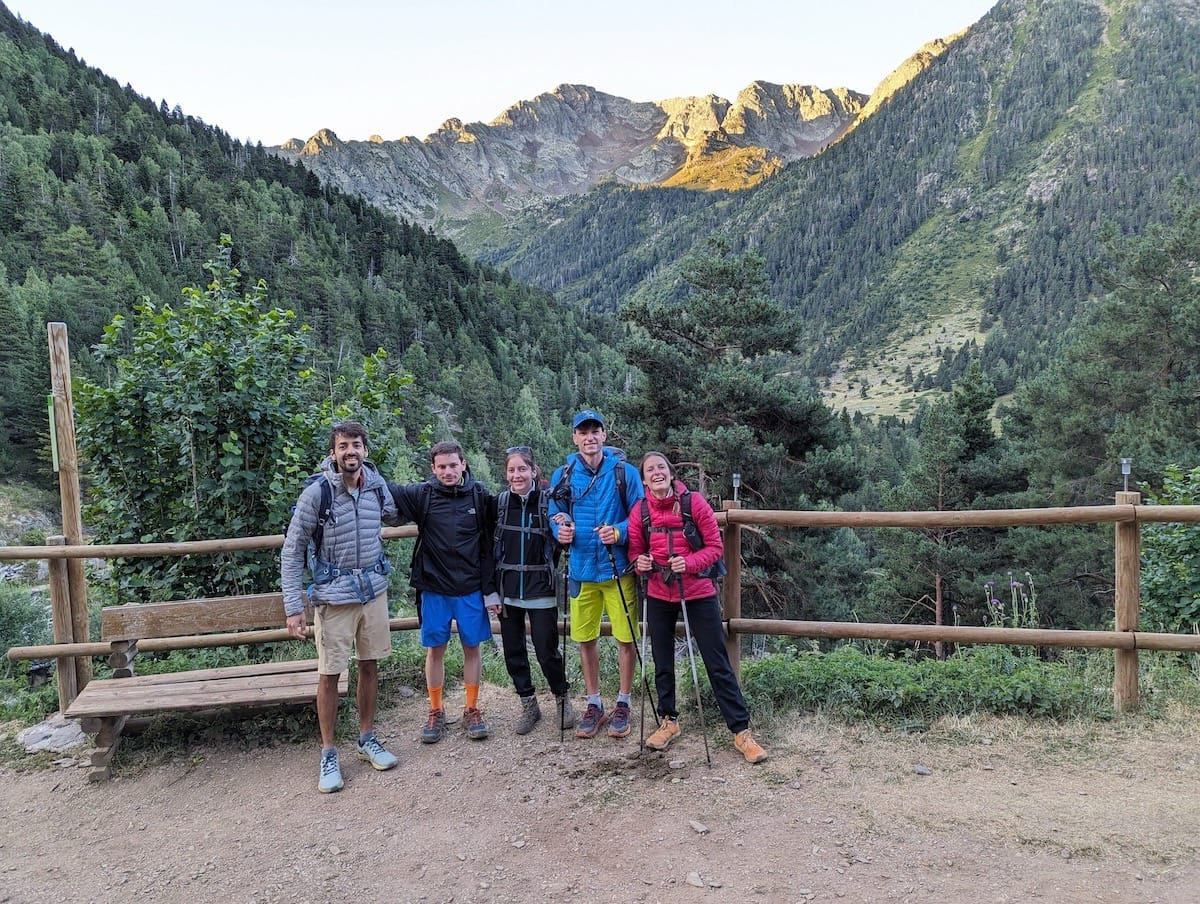
Portable charger
Another essential item for hut-to-hut hiking in the Pyrenees is a portable charger. While we always carry a physical map (just in case), we mainly rely on navigation apps like Wikiloc to follow the route. If our phone battery dies, we lose our navigation. And even worse, we wouldn’t be able to call for help in an emergency.
To stay prepared, we always download the track on more than one phone and carry a fully charged portable charger.
A charger with multiple charges is even better, so you can power up both your phone and any other devices, like a headlamp if needed.
👌 Our tip
Charge your devices during the evening or overnight if the hut has outlets. This way, you’ll save the portable charger for when you really need it!
Plastic bags
When you’re hiking hut-to-hut, the stages are often long, and you’ll likely need to eat snacks, a picnic, or sandwiches along the way. A plastic bag is super handy for keeping all your wrappers, fruit peels, and other trash together.
Most huts don’t let you throw away your trash there, so you’ll need to carry everything with you until you reach a village with proper disposal. A plastic bag makes it easy to keep your trash separate from your gear. Plus, you can hang it from your backpack if you don’t want to carry it inside your pack.
Plastic bags are also super useful for keeping your gear dry if it rains. Just pop your clothes, electronics, or anything delicate inside, and you’ll keep everything safe and dry.
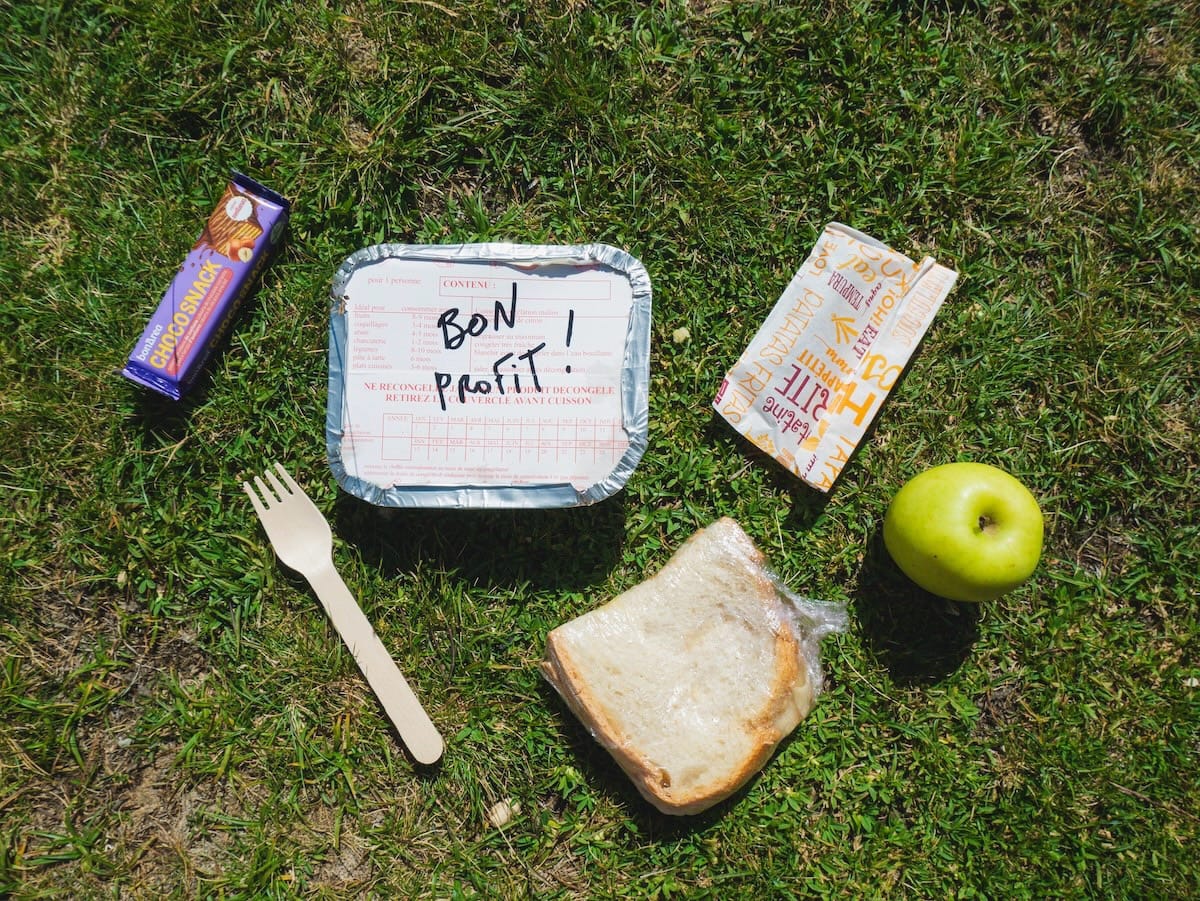
Sun protection
Being in Spain, the sun here in the Pyrenees mountains is really strong! As most of the hut-to-hut routes are at high altitudes, there are long stretches without a single shadow, especially around mountain passes.
If you’re hiking in August or during midday, be extra careful. Sometimes, you might not notice how hot the sun is because it’s a bit windy, but then, you get to the hut, and your arms and legs are all sunburned!
This happened to us on the third day of the Coronallacs hike, and it wasn’t a pleasant experience. Everything hurt, and we ended up wearing the same long-sleeve shirt for two days straight just to avoid making it worse.
Now, we always pack these three essentials to avoid a repeat:
🧴 Sunscreen
For your own health and the environment, look for one that is chemical-free. You’ll find them labelled as “reef-safe,” “mineral,” or “natural”. These don’t contain harmful chemicals, work effectively by blocking rays at the surface, and won’t harm sensitive mountain ecosystems if you take a dip in a lake.
🧢 Cap or hat
Lightweight ones are great because, well, because they don’t weigh! But they also dry faster when you soak them in water. For this reason, we prefer polyester ones. On hot days, we love dipping them in lakes or fountains. They stay wet longer and keep our heads cool.
👕 Long-sleeve shirt
We also recommend packing a breathable, long-sleeve shirt, which provides better sun protection than sunscreen and saves you the hassle of constant reapplication. Look for materials like merino wool for maximum comfort and breathability.
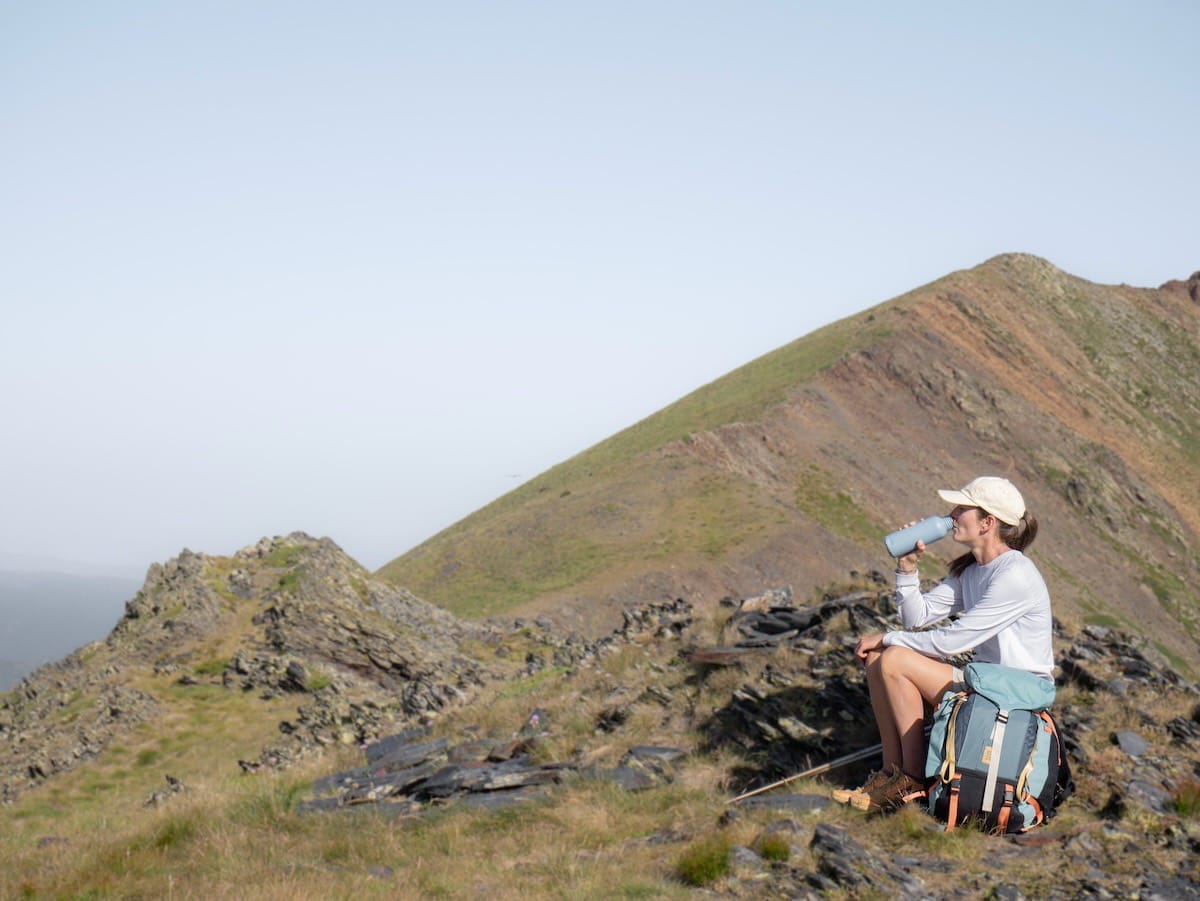
Hut-to-hut hiking routes in the Pyrenees
Now that you know everything you need to pack, it’s time to choose the route! To discover some incredible hut-to-hut hiking adventures in the Pyrenees, check our “Hut-to-hut hiking in the Pyrenees: Seven stunning routes + Essential info” guide.

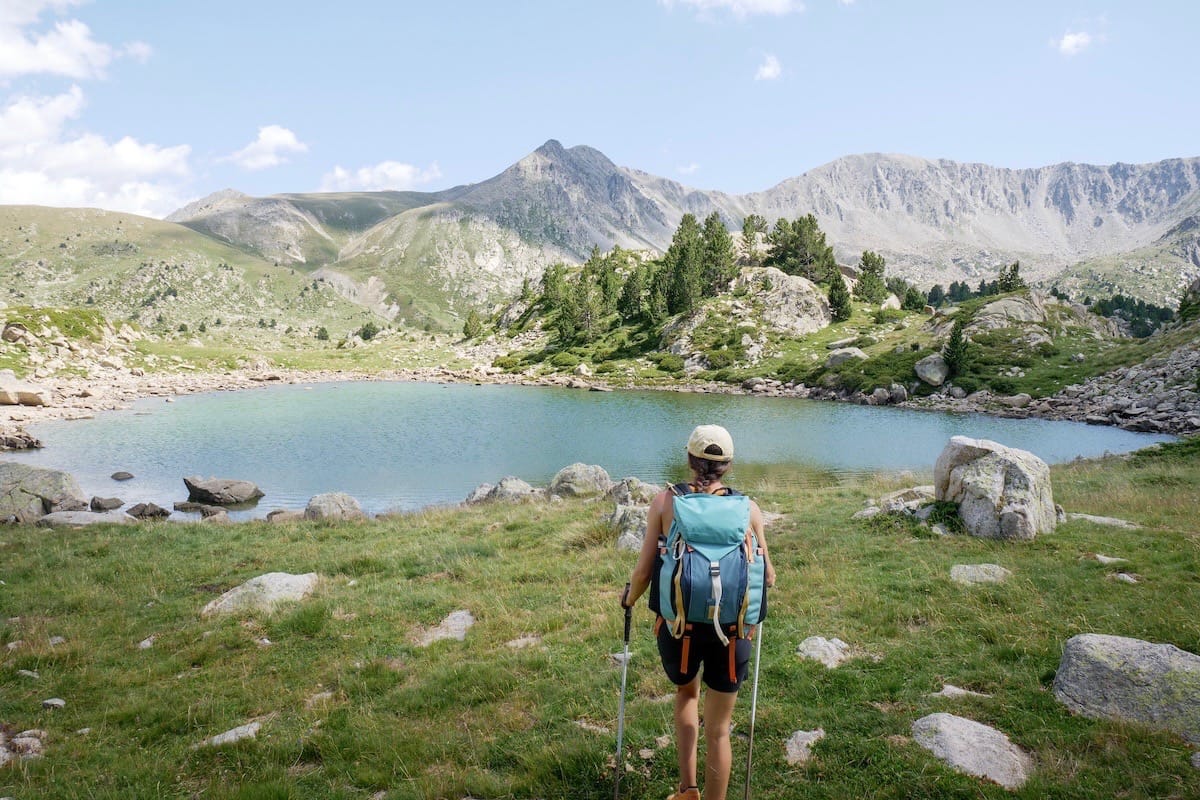


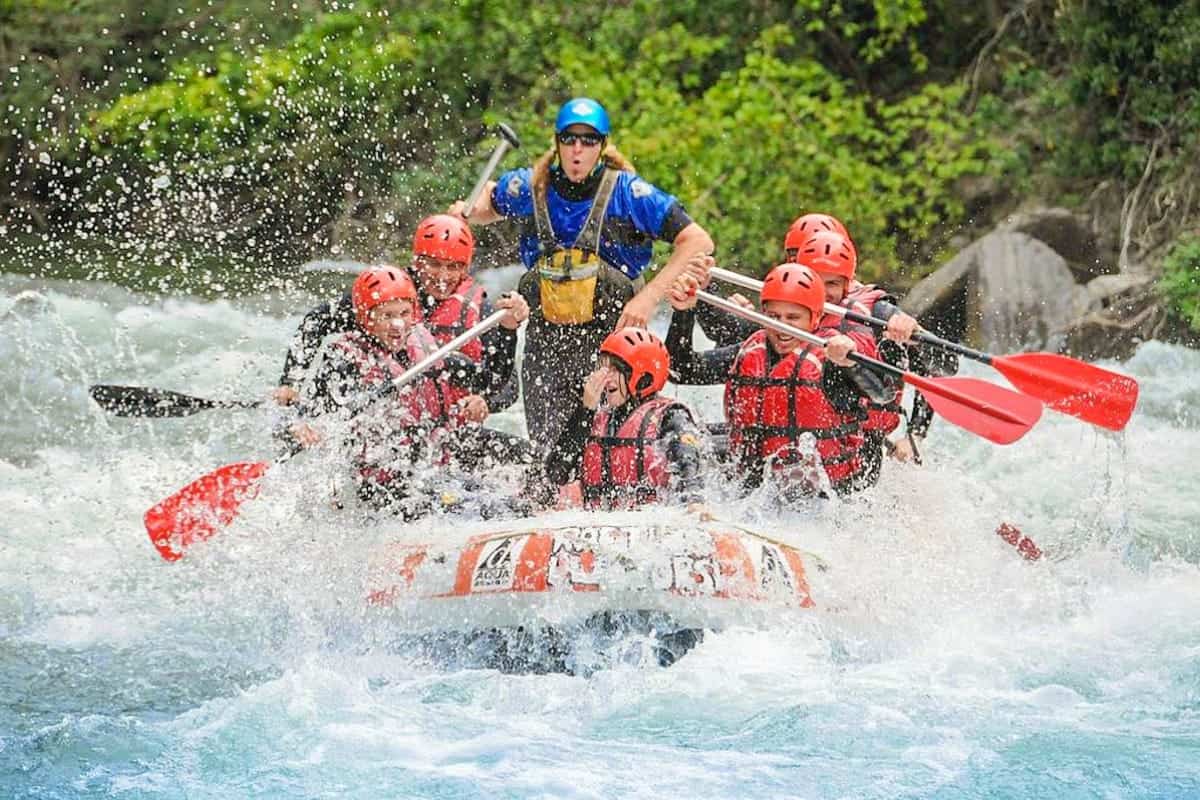

Thanks for the information. Do you have some advice on the necessity of a sleeping bag inside the huts on the Coronallacs route? I will be doing the route in early and was considering bringing a Sea to Summit sleeping bag liner rathe4 than a sleeping bag. Your experience and knowledge is greatly appreciated.
Hi Cris, all of the huts on the Coronallacs have pillows and blankets, so all you need to bring is bed linen. No need for a sleeping bag 🙂